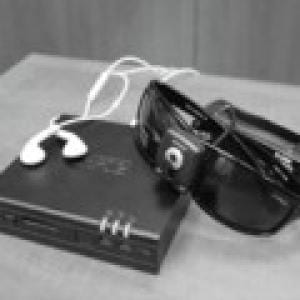A “sonar vision” system that enables people who are blind from birth to perceive the shape of a face, a house or even words and letters, is being developed by a team at the Hebrew University of Jerusalem.
Using this device, the researchers have shown that, in people that are blind from birth, the areas of the cerebral cortex normally devoted to reading become activated in response to stimulation.
The results of this study, conducted in conjunction with researchers at the ICM Brain and Bone Marrow Institute Research Center (Inserm/UPMC/AP-HP) and NeuroSpin (CEA-Inserm), were published in Neuron on November 8.
It is generally accepted that the visual cortex fails to develop normally in the congenitally blind, to such an extent that it can prove impossible to recover sight at a later point — even in cases where blindness can be corrected. In reality, the blind can indeed access a kind of vision, describe objects, and even identify written words and letters, using a “sensory substitution device” (SSD), which transforms images into sound.
These are the results demonstrated in the study conducted at the Edmond and Lily Safra Neuroscience Center (Hebrew University of Jerusalem). The study was conceived by researchers at the Hebrew University, who carried out the experimental components, with scientific support from French cognitive neuroimaging specialists.
The device consists in a small video camera embedded in a pair of eyeglasses, a laptop (or Smartphone) which transforms images into sounds, and stereo headphones to hear the sounds produced. For example, an oblique line is transformed into an increasingly high-pitched sound (or increasingly lower-pitched sound). The same principle is used to encode much more complex images in auditory form.
Using this system, the blind can achieve greater “visual” acuity than that defined as blindness according to WHO criteria.
After only 70 hours of specialized training, the blind are able to correctly classify images into different categories (faces, houses, etc.). They can also perceive other important information, such as where people are located in a room and certain facial expressions. They can even read words and letters (see videos at http://brain.huji.ac.il/).
In addition to the performance enabled by this sensory substitution system, the researchers at the Hebrew University wanted to understand what happens in the brain when a blind person learns to “see” through sound. To this end, they have developed a functional MRI study based on a specific paradigm.
In particular, they have shown that the regions of the cortex normally devoted to visual perception, which seem to serve no apparent use in the blind, become highly activated in response to the “sonar vision” of faces, houses and words, etc.
Not only is the visual cortex activated, it also demonstrates a “normal” functional selectivity of different categories of objects. Thus, in a sighted person, a very specific region of the visual cortex in the left hemisphere (known by the acronym VWFA), is known to become more activated when perceiving a string of letters than when perceiving any other kind of object. It is exactly this same region that is activated when a blind person reads letter using the “sonar vision” device.









